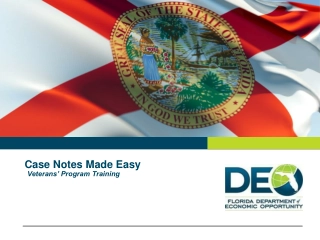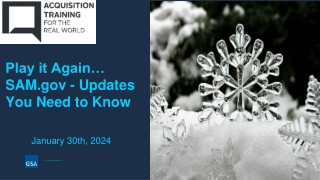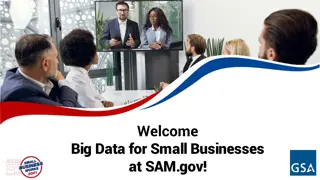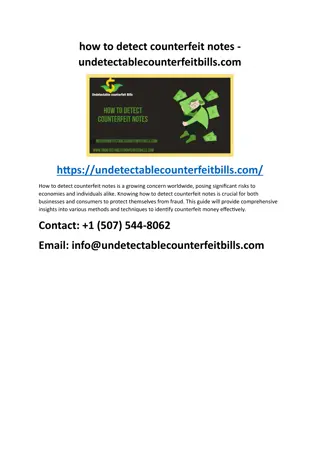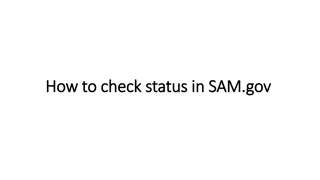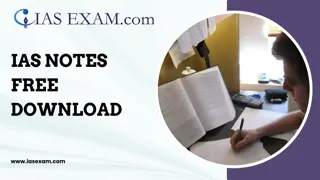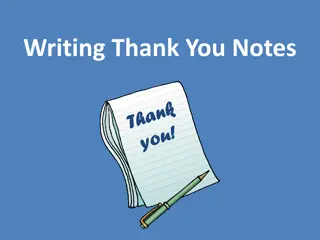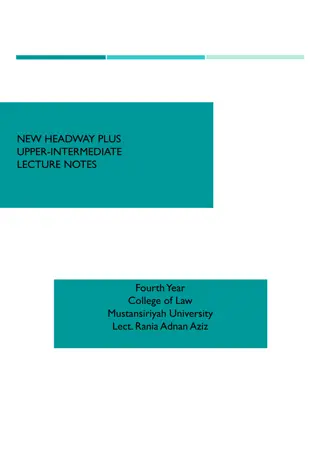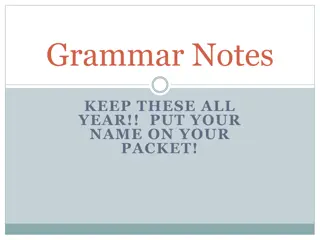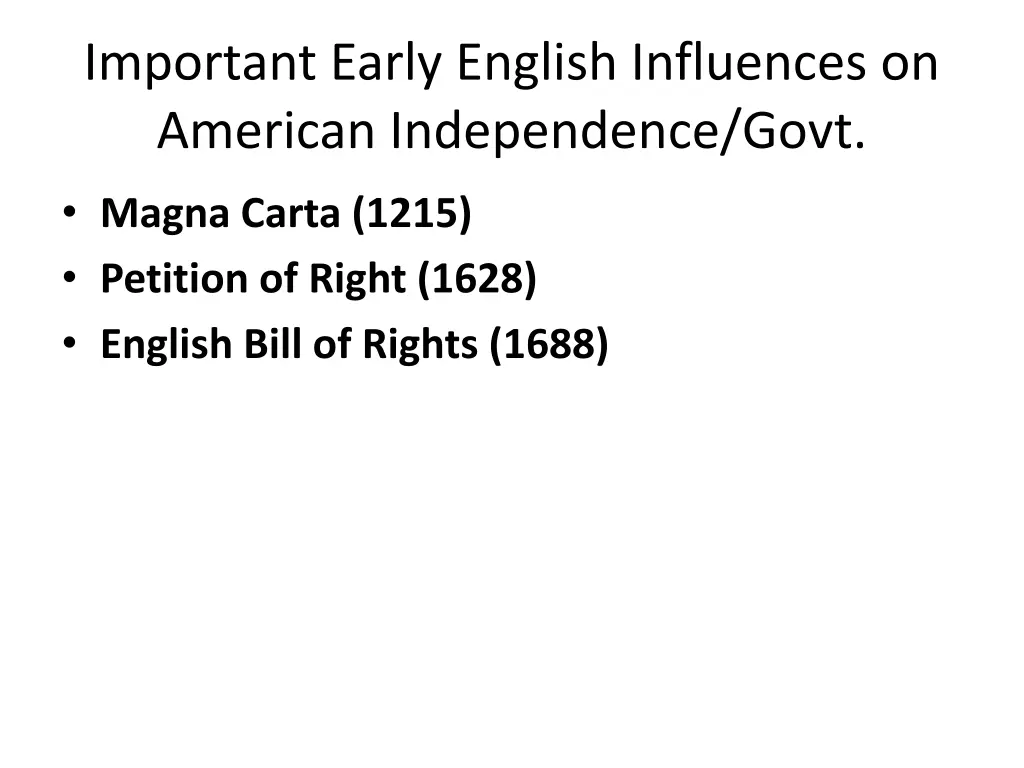
Early English Influences on American Independence & Government
Explore the significant impact of historic English documents like the Magna Carta, Petition of Right, and English Bill of Rights on American independence and government. Learn about the principles of limited government and representative government that influenced the formation of the United States.
Download Presentation

Please find below an Image/Link to download the presentation.
The content on the website is provided AS IS for your information and personal use only. It may not be sold, licensed, or shared on other websites without obtaining consent from the author. If you encounter any issues during the download, it is possible that the publisher has removed the file from their server.
You are allowed to download the files provided on this website for personal or commercial use, subject to the condition that they are used lawfully. All files are the property of their respective owners.
The content on the website is provided AS IS for your information and personal use only. It may not be sold, licensed, or shared on other websites without obtaining consent from the author.
E N D
Presentation Transcript
Important Early English Influences on American Independence/Govt. Magna Carta (1215) Petition of Right (1628) English Bill of Rights (1688)
ENGLISH INFLUENCE ENGLISH DOCUMENTS MAGNA CARTA (1215) SOME RIGHTS FOR THE UPPER CLASS-1215 Trial by Jury, due process of law, protections against the taking of life, liberty, estate (property) All of this to protect against an absolute ruler PETITION OF RIGHT (1628) AN EMERGING PARLIAMENT DEMANDS MORE POWER 1628 No martial law, no quartering troops w/o consent, no taxes w/o parliament s consent
ENGLISH INFLUENCE ENGLISH DOCUMENTS ENGLISH BILL OF RIGHTS (1688-89) GREAT RESTRICTIONS PUT ON THE MONARCHY (William and Mary) BY THE PARLIAMENT 1689 Prohibited a standing army in peacetime, required all parliamentary elections to be free, no cruel and unusual punishment, protection from excessive bail King and Queen had to have consent of Parliament for most actions
ENGLISH INFLUENCE 2 ACCEPTED PRINCIPLES LIMITED GOVERNMENT Government restricted in what they can do MAGNA CARTA, ENGLISH BILL OF RIGHTS, PETITION OF RIGHTS REPRESENTATIVE GOVERNMENT- Government should serve the will of the people PARLIAMENT, HOUSE OF LORDS, HOUSE OF COMMONS
Influence of Enlightened Ideas Thomas Paine Common Sense The King of England was a tyrant who had broken social contract Got into the hearts and minds of colonists The Social Contract Written by Rousseau, popularized by Hobbes and Locke British view: Colonists had committed treason in eyes of King
Social Contract Describes the relationship of man with society. The state of nature is a brutish condition without law or morality, and that there are good men only as a result of society's presence. Because he can be more successful facing threats by joining with other men, he joins together with his fellow men to form a "society." "The Social Contract" is the agreement among men that sets the conditions for membership in society.
Social Contract Thomas Hobbes Earliest humans lived in unbridled freedom. A state of nature with no government and no person was subject to superior power That which people could take by force belonged to them might is right No authority existed to protect one person from the aggressive actions of another You were only has safe as your own physical strength and intelligence could make you Humans escaped this unpleasant condition by agreeing to create a state (government). The Social Contract was this agreement. People exchange most of their freedoms for safety or organized society.
Social Contract Jean Jacques Rousseau Government exists to serve the general will of the people (the majority). The general will would act in the best interest of the people.
Social Contract John Locke Relationship between a man and society and society and its government Government s main purpose is to carry out the will of its people and protect their natural rights Natural Rights = Life, Liberty, and Estate (property) Any government which does not do this is therefore not legitimate And the people have the right to revolt and change it Greatly influenced Thomas Jefferson and Declaration of Independence
John Locke Quotes The end of law is not to abolish or restrain, but to preserve and enlarge freedom. For in all the states of created beings capable of law, where there is no law, there is no freedom. The reason why men enter into society is the preservation of their property.
Lockes Second Treatise (essay) on Government Read the passage from Locke s Second essay on page 11. Answer questions 1-4. Locke s premise that governments are entered into by the consent of free and equal men, was very controversial in 1690. # 5 Why would this be controversial in 1690? # 6 - Do any of these reasons sound controversial today? Why or why not?
Americans win independence I. Americans win independence a. 1776 Declaration of Independence b. Written to break away from England c. Thomas Jefferson main author used Enlightened Ideas (Preamble: Gov t. power is derived from people) d. Committee of Five Jefferson, John Adams, Benjamin Franklin, Robert R. Livingston, and Roger Sherman
Preamble to Declaration of Independence Part 1 Preamble We hold these truths to be self-evident, that all men are created equal, that they are endowed, by their Creator, with certain unalienable Rights, that among these are Life, Liberty, and the pursuit of Happiness. That to secure these rights, Governments are instituted among Men, deriving their just powers from the consent of the governed, That whenever any Form of Government becomes destructive of these ends, it is the Right of the People to alter or abolish it, and to institute new Government, laying its foundation on such principles, and organizing its powers in such form, as to them shall seem most likely to effect their Safety and Happiness.
Declaration of Independence Part 2 List of Grievances A blow by blow indictment on King George of the ways in which he had broken the social contract.
DECLARATION OF INDEPENDENCE PART 3 The Actual Declaration We, the Representatives of the united States of America, in General Congress, Assembled, appealing to the Supreme Judge of the world for the rectitude of our intentions, do, in the Name, and by Authority of the good People of these Colonies, solemnly publish and declare, That these united Colonies are, and of Right ought to be Free and Independent States.
Questions 1. Review the excerpt from the preamble to the Constitution. What enlightenment ideas are included? 2. The Declaration of Independence states that all men are equal and are endowed with certain unalienable rights, that among these are life, liberty, and the pursuit of happiness . Was this statement a fact or opinion back in 1776? Explain. 3. What about in 2019? 4. If you lived during the 1760 and 1770 s, do you think you would have supported the call for revolution, why or why not and at what point?
A CRITICAL PERIOD JUST BEFORE AND AFTER THE REVOLUTION AMERICAN REVOLUTION BASICALLY ENDS WITH LORD CORNWALLIS SURRENDER AT YORKTOWN, VA IN OCT. 1781 (war officially ends with Treaty of Paris on September 3, 1783) The Second Continental Congress acted as Government but all States had individual State Constitutions Articles of Confederation approved on Nov. 15, 1777 But do not go into effect until March 1, 1781 (needed all 13 states to approve)
ARTICLES OF CONFEDERATION Creates only a legislative branch of government = a Congress that could - Make war & peace, send and receive ambassadors, make treaties, set up monetary system, borrow money, establish post offices, build a Navy, raise an army (by asking state for troops), settle disputes amongst the states - However, this Congress had to rely on the states to accomplish anything
ARTICLES OF CONFEDERATION WEAKNESSES- no tax, weak defense, no power to regulate trade between states, 1 vote per state (9-13 to pass/execute laws), no executive or judicial branch (therefore lacked power to make states obey) Congress owed the States lots of money from Revolution debts not paid State Governments were on the verge of bankruptcy Nothing national government could do! It had no money!
John Hanson First President of the United States?
Assignment on blog Articles of Confederation Watch video clip
Problems that led to Shays Rebellion States taxed each others goods or even banned trade (like a tariff) States printed their own money (often without anything backing it). Economic chaos prices soared, sound credit vanished, debt rose public and private both went unpaid. Violence broke out all over, not just MA. Demand for stronger national government to solve problems rose.
Shays Rebellion 1786 Shay s Rebellion prompts need for stronger national government Farmer s rebelled against Mass. State Gov t. Over huge debt, heavy taxes, & foreclosures Federal Gov.t could not act, MA Gov.t needed help Shay s forces attack the Springfield federal armory (rifles) Eventually rebellion was put down by Boston & Springfield Militia 1,000 arrested, Shays and dozens of others would be condemned to death. He was later pardoned in 1788.
Americas new government I. Articles of confederation a. First constitution of US? = Created a weak national government that loosely connected the states into a union.
PHILADELPHIA CONVENTION 55 MEN (Average age approx 44) WHITE EDUCATED LAND OWNERS START ARRIVING IN PHILADELPHIA EARLY MAY 1787 THE NEEDED QUORUM IS MET ON MAY 25, 1787 & CONVENTION CAN BEGIN THESE MEN BECAME KNOWN AS THE FRAMERS OF THE CONSTITUTION More details on framers pages 48-49 EACH ARRIVED WITH GOALS AND RESPONSIBILITY TO SATISFY THE PEOPLE BACK HOME.
METHOD OF DECISION MAKING ALL WAS TO BE DONE IN SECRET Many different ideas would set the method needed to reach conclusions DISCUSSION, COMPROMISE, CONSENSUS CONSENSUS 100% AGREEMENT WHAT ARE THE POSITIVES AND NEGATIVES RELATED TO THIS TYPE OF DECISION-MAKING?
VA Plan vs NJ Plan for Govt All States brought there own plans for our new government but two emerged The Virginia Plan 2 House Legislature Representation proportionate to a states population The New Jersey Plan Single House Legislature Equal representation for all state regardless of population The GREAT DEBATES would center around one big question
THE GREAT DEBATES WHO WOULD HAVE POWER? Representation; BIG STATES or SMALL STATES? BICAMERAL LEGISLATURE (Senate/House) CENTRAL or LOCAL? FEDERALISM (Division of Power) WITHIN THE FEDERAL GOVERNMENT? BRANCHES OF GOVT / SEP. OF POWERS / CHECKS & BALANCES PEOPLE AND THE GOVERNMENT? BILL OF RIGHTS / AMENDMENTS
The Philadelphia Convention I. The Constitutional Convention Creates a new Constitution a.Great Compromise (CT Compromise) two house legislature created (Bicameral) Upper house all state equal representation Lower house based on population of state b.Three Fifths Compromise In response to southern slave population non-free people would count as 3/5tha person toward representation But would also be included in amount of direct tax levied by Congress
Federalism c.Separation of Powers Distrust for powerful central government Legislative, executive, and judicial Checks and balances Division of federal and state governments Powers Granted Example of Federalism Bill of rights To protect rights of citizens; majority rule vs. minority rights 10 Amendments d.Government based on law not royal power or divine right. Religion never even mentioned. God, but no specific religion.
Purpose of 3 Branches of Government 1. Legislative Make law 2. Executive Carry out law 3. Judicial interpret law *Although they operate independently, the system of checks and balances forces them to work together. *Federalism
Structure of Constitution 3 Main Parts of the Constitution 1. Preamble Introduction 2. Articles Seven numbered sections 3. Amendments Formal changes
Thomas Jefferson These principles form the bright constellation which has gone before us and guided our steps through an age of Revolution and Reformation .
Structure of the US Constitution 7 Articles, (later 10 Amendments 1791), now 27 Amendments Worlds oldest and shortest continuously used Constitution (a little over 225 years) about 7,000 words (why? vague and flexible) Article I Powers of Congress Article II Powers of President / Elections Article III Judicial Powers / Supreme Court Article IV States Powers and Rights (Representative Democracy Republican) Article V Adding an Amendment (2/3 of Congress, States) Article VI (Supremacy Clause) supremacy of national government over state and local, oaths of office, public debts Article VII Provisions for ratification of Constitution / state conventions 9 of 13
RATIFICATION RATIFY TO FORMALLY APPROVE A DOCUMENT. GREAT DEBATES FINALLY COME TO CONCLUSIONS MANY CALL THE CONSTITUTION A BUNDLE OF COMPROMISES . THE BICAMERAL LEGISLATURE CREATED BY THE GREAT COMPROMISE IS AN EXCELLENT EXAMPLE OF THIS
Ratification The Constitution could have been officially ratified in the summer of 1788 after New Hampshire became the 9thstate to ratify Virginia & New York were missing Key States They would ratify in June and July Now with 11 of 13 states under the federal roof , Congress would move forward with the Constitution as our new government in September of 1788. North Carolina and Rhode Island still not on board but would eventually ratify.
Ratification New York becomes the Capital (temporary) The new congress meets in NYC on March 4, 1789 to elect our first President, but lacked a quorum (enough votes to count) Washington is not officially elected until April 6, 1789, winning all electoral votes to become our first President (John Adams elected VP) Washington takes his oath of office on April 30, 1789 New government is now fully in effect!
EFFECTS OF RATIFICATION LED TO THE EMERGENCE OF POLITICAL PARTIES THE FEDERALISTS G. WASHINGTON, A. HAMILTON, J. ADAMS, J. MADISON. Those that favored ratification. Supported strong central government. Stressed weakness of Articles of Confed. THE ANTI- FEDERALISTS T. JEFFERSON, P. HENRY, J. HANCOCK, S. ADAMS Those who opposed ratification. Stressed concern over increased power of government and lack of Bill of rights. I look upon that paper as the most fatal plan that could possibly be conceived to enslave a free people Patrick Henry SENT TO THE STATES FOR APPROVAL.
FEDERALIST PAPERS A collection of 85 essays LOGICAL ARGUMENTS WERE MADE WHY A NEW GOVERNMENT WAS NEEDED DESCRIBE THE STRUCTURE THEY DEVELOPED WHY THE PEOPLE SHOULD RATIFY MAIN AUTHORS ALEXANDER HAMILTON, JAMES MADISON, JOHN JAY
RATIFICATION ONE FINAL GREAT DEBATE WOULD TAKE PLACE DURING THE RATIFICATION PROCESS PROTECTION FROM A TOO POWERFUL GOVERNMENT WHAT IS USED, TODAY, AS THE ULTIMATE PROTECTION FOR PEOPLE, OFTEN PEOPLE IN A MINORITY? THE BILL OF RIGHTS
Quotes "A bill of rights is what the people are entitled to against every government on earth, general or particular; and what no just government should refuse, or rest on inferences." --Thomas Jefferson The Constitution is not an instrument for the government to restrain the people, it is an instrument for the people to restrain the government lest it come to dominate our lives and interests . PATRICK HENRY
Crash Course Video Clip Civil Liberties and Civil Rights



